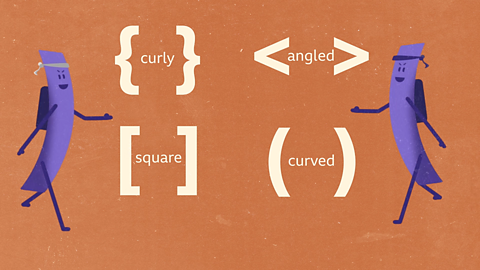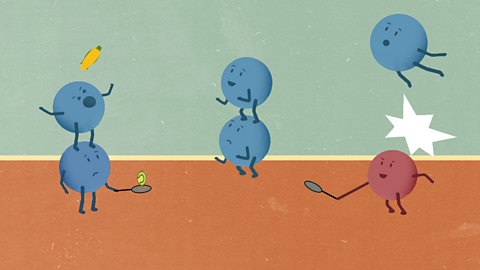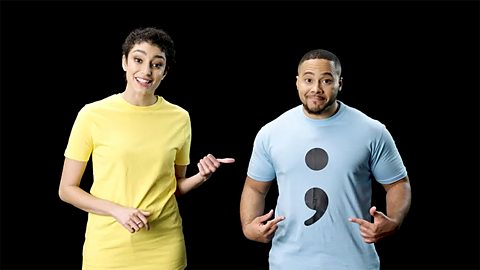Did you know?
The Romans and the Ancient Greeks didn’t use punctuation at all. They didn’t even have gaps between words.
This is called scriptio continua, writing as one continuous string of capital letters, so their WRITINGWOULDLOOKLIKETHIS.
Introduction to revising basic punctuation
The most commonly used punctuation are:
- capital letters and full stops
- commas to separate clauseA sentence or part of a sentence that has a subject and a verb.
- exclamation marks and question marks
- quotation marks
Key learning points
- How to use punctuation effectively and correctly
- How to spot when punctuation has been missed or used incorrectly
- How to use punctuation to create meaning and emphasis
Video about how to use basic punctuation
Video explaining different types of punctuation used to make sentence clearer
Meet the punctuation team: heroes at the ready to save your sentence.
Punctuation makes text easier to read your writing needs it to make sense ok
Punctuation makes text easier to read. Your writing needs it to make sense. Ok.
(Clears throat) Ok?
(Barking): Ok! Enough!
Exclamation marks should be used sparingly.
(Reads it out as if there are no commas): Commas keep the items in lists separate add… separate add?
Commas keep the items in a list separate, add information and make meaning clear.
I love cooking my pet dog and video games. I mean I love cooking my pet dog.
I love cooking my pet dog?
I mean, I love cooking, my pet dog, and video games.
That’s better! Thanks, comma! Before you, go turn off the lights.
Ah, I mean, before you go, turn off the lights.
Why we use punctuation
When punctuation is not used, or used incorrectly, sentences can become difficult to read and understand.
Punctuation is a very important, useful and powerful writing tool:
- It is responsible for creating meaning and helping us communicate clearly.
- It guides our understanding of written language – taking the place of things we might do naturally when we speak – like pause, raise our voice or show emotion.
- It helps create structure, rhythm, pace and tone.
- It has as much significance as the words and language devices we use.
- It is an integral part of grammar and spelling.

Compare these two paragraphs. How do you think punctuation has made them easier to read, understand and follow?
A. the happiest days that i remember to this day they are those days in my youth when mum and dad dealt with any troubles nowadays i deal with everything and you have no idea how I yearn for those carefree days even if only just for just one week
B. The happiest days that I remember? To this day, they are those days in my youth when Mum and Dad dealt with any troubles. Nowadays, I deal with everything and you have no idea how I yearn for those carefree days, even if only for just one week!
Paragraph B is a lot easier to follow. Note how the question mark, commas and exclamation change the meaning and the emphasis of what is said:
The happiest days that I remember? (this sentence introduces the reason for the paragraph, the question mark indicates that a question is being answered) To this day, they are those days in my youth when Mum and Dad dealt with any troubles (the full stop breaks up the paragraph, so that the two sentences talk about the past and the present). Nowadays, I deal with everything and you have no idea how I yearn for those carefree days, even if only for just one week! (the exclamation mark indicates an emphatic tone or strong emotions)
Capital letters and full stops
Capital letters are used:
- At the start of sentences, when the first word is always capitalised
- For proper nouns
- The names of people and their titles (Miss Smith, Professor Ball)
- Places including street names, cities and countries
- Brands and companies
- Days of the week, months and special days (like Valentine’s Day);
- Religions, nationalities and languages.
- For abbreviations
- TV (short for television), NW (short for north-west) or ≥…»ÀøÏ ÷ (British Broadcasting Corporation).
- For titles of books or films
- Pride and Prejudice or Spider-Man: No Way ≥…»ÀøÏ ÷.
- The pronoun ‘I’ (what you call yourself) is always in capital letters.
Sometimes, writers also use capital letters to suggest shouting eg ‘‘WATCH OUT!’’, or for emphasis eg ‘‘He is HUNGRY!’’
Full stops (.) are used:
- To mark the end of a complete sentence.
- To mark the end of a complete thought, argument or point.
- They cannot be exchanged for commas without changing the wording or structure of a sentence.
Find the missing capital letters
Commas to separate clauses
Commas (,) can help to make sentences easier to read and understand. There are several reasons to use commas:
Using a comma to separate clauses:
Before Lucia could relax, she needed to finish her homework.Using a comma to create lists:
Henry was angry, determined and single-minded.Using a comma to avoid repetition:
Alberto is the tallest in the class and Caoimhe, the smallest.Using a comma to introduce direct speechSpeech that is spoken. :
Nadeem left the house shouting, “See you later, Mum!”Using a pair of commas to add information:
Gemma, who loved music, always wanted to hear Rishon play his guitar.

Where would these comma go in these two instances?
Place a comma after the main clause to separate it from the subordinate clause:
You can use an egg pricker to make a very small hole in each egg before boiling which will also reduce the chances of it cracking in the heat.
This example begins with a subordinate clause. Place a comma to separate it from the rest of the sentence:
If serving with a salad plunge the eggs into a bowl of cold water as soon as the timer goes off.
Place a comma after the main clause to separate it from the subordinate clause:
You can use an egg pricker to make a very small hole in each egg before boiling**,** which will also reduce the chances of it cracking in the heat.
Place a comma at the beginning of the sentence to separate the subordinate clause:
If serving with a salad**,** plunge the eggs into a bowl of cold water as soon as the timer goes off.
Exclamation marks and question marks
Exclamation marks (!)
Exclamation marks are used to express loudness, an emphatic tone or strong emotions such as excitement, anger, exasperation, alarm. For example: ‘‘Help!’’ she yelled. This suggests she needs help urgently.
How exclamation marks should be used:
- With care and precision for maximum impact – one exclamation mark is usually enough!
- Using exclamation marks incorrectly reduces their impact and value. This can make the writing overly dramatic, or the character overly emotional for no real reason.
- Exclamation marks usually end sentences so what follows them should be capitalised as the start of a new sentence.
Question marks (?)
Question marks are used to ask a question or to show that a question has been asked, even if it is thought.
For example:
What are you doing after school today?
“Can I borrow a pen?” she asked.
Why didn’t we go to the park first to check if they were there? Jamie thought irritably.
How question marks should be used:
- Placed at the end of the question sentence.
- Typically to close question sentences that start with what, where, how, do, are, could, should, when and why.
- Question marks end sentences so the next sentence should start with a capital letter.
What does the exclamation mark in this excerpt tell you about Ramlal?
Ramlal came up in the mule cart and called out, 'Work faster! We a whole cartload behind!' Then he saw Romesh and he came down from the cart and walked rapidly across. 'So you come! Is a good thing you make your mind!'
The exclamation marks show that the character Ramlal is an irritable person that speaks loudly, impatiently and is bossy.
Quotation marks
Speech marks, also known as double quotation marks, ‚Äò‚∂ƒò‚∂ƒ¶‚∂ƒô‚∂ƒô are used to show when someone is speaking. Quotation marks, or single quotation marks, ‚Äò‚∂ƒ¶‚∂ƒô are used for quoting word-for-word, what someone else has written or said.
How quotation marks should be used:
- The words and phrases being quoted (and any punctuation marks) should be inside of the quotation marks.
- When quoting a text, quotation marks show that what has been written is identical to the original text or speech copied. If any words or phrases are taken out then ellipsis (…) need to be used to show where words or phrases are missing.
- UK English typically uses single quotation marks ‘a’ and American English uses double quotation marks “b”.
- There are occasions when you would use both single and double quotation marks, such as when you are quoting something already in speech marks. For example:
The author writes ‘Nat spoke softly, “Tell me where she is”’ to show that Nat is desperate.
Find out more about how to punctuate quotations and how to punctate direct speech.
Test your knowledge
Play Bitesize secondary games. gamePlay Bitesize secondary games
Have fun playing science, maths, history, geography and language games.

More on Punctuation
Find out more by working through a topic
- count2 of 11

- count3 of 11

- count4 of 11

- count5 of 11
